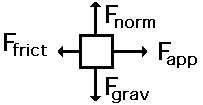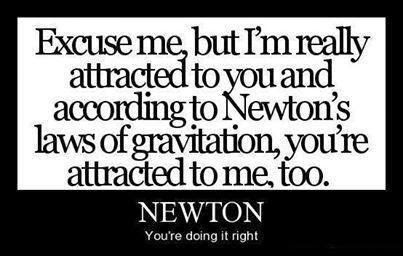Inertia and Newton's 1st Law
Today in class we mainly watched "Eureka" videos about inertia and elements related to it. We also took notes, read from the book, and had a little discussion.
Now, I will give three examples in my life that show the correlation between inertia, Newton's 1st Law, and how massive something is:
1). When I was younger and living in another location in MA (Woburn), I used to live in an apartment complex and at that complex I used to roll down hills for fun (sounds crazy right? It definitely explains a lot). Either that or I'd ride down a hill with my bike. Any ways, I remember whenever I rolled my bike down the hill on its own it would always roll quite fast, but whenever I was on it it was a little slower going down the hill. Also, I usually stopped at the bottom of the hill on my own, but if I was on my bike I would keep going down the hill onto the grass and down towards another hill sometimes! And I did not change my speed either, though inertia is not dependent on speed so we need not worry about that. This situation shows inertia because with more massive objects (it being me on the bike here) there is more inertia. If there is more inertia then the body will have a hard time changing its current state of motion because the greater the inertia, the greater the tendency an object will have to keep doing what it is doing! And that is what happened here, the bike and I were in motion BUT it was harder to stop us in comparison to just me rolling down the hill which was easier to stop. I have less inertia than the bike and I combined. You'll notice how more massive objects are harder to move AND to stop. Whereas less massive objects do not have that problem as much. The amount of mass affected the inertia and how fast the bodies would stop and start, as a result I continued going longer on my bike than by myself.
2). Or, sometimes I need to move things around in my room like my bed or my chair. When my chair does not have a massive backpack on it it is extremely easy to put in motion, whereas it is harder to push my bed into motion. These objects have and show inertia because they are so lazy I gotta move them! Nah, the real reason why is because with inertia an object at rest will stay at rest or stay in motion; the body wants to do what it is currently doing, and since both my bed and chair are at rest they will stay at rest because they are stubborn as hell. Here, the big mass for the bed (especially with the dense mattress and iron bed post) affects how easy it is for me to get it out of rest. It takes a bit of force for me to really move it, but the chair is so much lighter; less dense and massive, so I can push it with ease and without having to go to the chiropractor's (I fall a lot--DON'T JUDGE MEEE).
3). And finally, I don't know if this counts, but when I turn off a fan in motion it usually does not come to an instant stop. Whenever I hit the treadmill in our little extension room I usually need to turn on the fan and open the door just to stay cool (not that I don't already look cool [l i e s]), and I set my fan on the highest setting. But when I stop it, it takes a few seconds for the blades to stop spinning. The blades represent inertia by not stopping its course of motion just yet. The fan is quite massive, especially at the bottom, so it is definitely hard to move due to that AND the blades don't stop instantly because with more massive objects there is more inertia therefore it is harder to get the blades out of motion. The state of motion before I turned the fan off was not in rest, so the fan had the naturally tendency to want to stay in rest but was stopped by me and the surrounding forces around it.
BONUS: 4). I see many vehicles on the roads nearby every single day, especially since the bridge is right down the street for me because the intersection is close, but I've seen many vehicles zoom by and when the red light flashes I notice that smaller vehicles are easier to stop than bigger ones. You can see inertia in such a situation because the big vehicles have a larger tendency to stay in motion than the smaller ones due to their huge mass! The bigger vehicles did stop, but they jerked forward as well before stopping. But the smaller vehicles probably stopped a little faster due to their smaller tendency to stay in their current motion. Both vehicles demonstrated their inertia by how they preserved their state of motion.
5). Whenever I drop cereal (:-((( and lose my breakfast) the cereal usually falls down onto the floor but then stops immediately, on the other hand, when I drop something like coins (not the chocolate ones; it's not Easter yet, guys) they take a while to get back to rest. The coins show great inertia because in their motion they try to continue it by spinning and scattering on the floor once they fall, but the cereal just tumbles onto the ground and stops. The mass once again makes the objects stronger in their preservation of motion or weaker.
More force is needed for more massive objects, and the mass matters, not the SIZE/VOLUME. Focus on the mass like 5 kg and ignore everything else because inertia is dependent on mass.
All of these examples tie to inertia, Newton's 1st Law, and mass because the mass of the bodies mentioned affected the inertia of the objects and inertia is related to Newton's 1st Law due to the fact that Newton's 1st Law relates to an object's constant or resting motion.
More force is needed for more massive objects, and the mass matters, not the SIZE/VOLUME. Focus on the mass like 5 kg and ignore everything else because inertia is dependent on mass.
All of these examples tie to inertia, Newton's 1st Law, and mass because the mass of the bodies mentioned affected the inertia of the objects and inertia is related to Newton's 1st Law due to the fact that Newton's 1st Law relates to an object's constant or resting motion.












